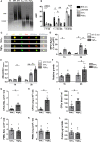Nuclease activity and protein A release of Staphylococcus aureus clinical isolates determine the virulence in a murine model of acute lung infection
- PMID: 37849760
- PMCID: PMC10577289
- DOI: 10.3389/fimmu.2023.1259004
Nuclease activity and protein A release of Staphylococcus aureus clinical isolates determine the virulence in a murine model of acute lung infection
Abstract
Staphylococcus aureus is a common cause of hospital-acquired pneumonia associated with high mortality. Adequate clinical treatment is impeded by increasing occurrence of antibiotic resistances. Understanding the underlying mechanisms of its virulence during infections is a prerequisite to finding alternative treatments. Here, we demonstrated that an increased nuclease activity of a S. aureus isolate from a person with cystic fibrosis confers a growth advantage in a model of acute lung infection compared to the isogenic strain with low nuclease activity. Comparing these CF-isolates with a common MRSA-USA300 strain with similarly high nuclease activity but significantly elevated levels of Staphylococcal Protein A (SpA) revealed that infection with USA300 resulted in a significantly increased bacterial burden in a model of murine lung infection. Replenishment with the cell wall-bound SpA of S. aureus, which can also be secreted into the environment and binds to tumor necrosis factor receptor -1 (TNFR-1) to the CF-isolates abrogated these differences. In vitro experiments confirmed significant differences in spa-expression between USA300 compared to CF-isolates, thereby influencing TNFR-1 shedding, L-selectin shedding, and production of reactive oxygen species through activation of ADAM17.
Keywords: L-selectin shedding; SpA; Staphylococcus aureus; TNFR shedding; lung infection; neutrophil extracellular traps; neutrophil recruitment.
Copyright © 2023 Ludwig, Thörner-van Almsick, Mersmann, Bardel, Niemann, Chasan, Schäfers, Margraf, Rossaint, Kahl, Zarbock and Block.
Conflict of interest statement
The authors declare that the research was conducted in the absence of any commercial or financial relationships that could be construed as a potential conflict of interest. The author(s) declared that they were an editorial board member of Frontiers, at the time of submission. This had no impact on the peer review process and the final decision.
Figures




References
-
- Diekema DJ, Richter SS, Heilmann KP, Dohrn CL, Riahi F, Tendolkar S, et al. . Continued emergence of USA300 methicillin-resistant Staphylococcus aureus in the United States: results from a nationwide surveillance study. Infect Control Hosp Epidemiol (2014) 35:285–92. doi: 10.1086/675283 - DOI - PubMed
-
- Kerem BS, Zielenski J, Markiewicz D, Bozon D, Gazit E, Yahav J, et al. . Identification of mutations in regions corresponding to the two putative nucleotide (ATP)-binding folds of the cystic fibrosis gene. Proc Natl Acad Sci USA (1990) 87(21):8447–51. doi: 10.1073/pnas.87.21.8447 - DOI - PMC - PubMed
Publication types
MeSH terms
Substances
LinkOut - more resources
Full Text Sources
Medical
Miscellaneous

